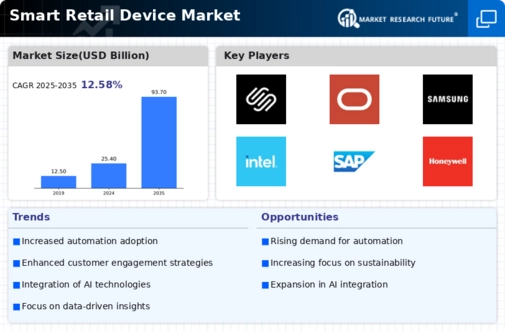Growth of E-commerce
The Smart Retail Device Market is experiencing a notable surge due to the growth of e-commerce. As online shopping continues to gain traction, retailers are adopting smart devices to enhance their online presence and streamline operations. The e-commerce sector is projected to reach a valuation of over 6 trillion dollars by 2024, prompting retailers to invest in smart technologies that facilitate seamless transactions and improve customer engagement. Smart retail devices, such as automated checkout systems and personalized marketing tools, are becoming essential for businesses aiming to compete in the digital marketplace. This shift towards e-commerce is likely to propel the Smart Retail Device Market forward, as retailers seek innovative solutions to meet the demands of tech-savvy consumers.
Adoption of IoT Technologies
The Smart Retail Device Market is witnessing a significant boost from the adoption of Internet of Things (IoT) technologies. Retailers are increasingly utilizing IoT-enabled devices to monitor inventory levels, track customer movements, and optimize supply chain operations. The IoT market in retail is projected to grow at a compound annual growth rate of 30% over the next few years, indicating a strong trend towards smart retail solutions. By implementing IoT technologies, retailers can achieve greater operational efficiency and reduce costs, which is crucial in a highly competitive market. This widespread adoption of IoT devices is likely to serve as a major driver for the Smart Retail Device Market, as businesses seek to leverage technology for improved performance.
Focus on Operational Efficiency
The Smart Retail Device Market is increasingly shaped by a focus on operational efficiency. Retailers are investing in smart devices that streamline processes, reduce labor costs, and enhance productivity. Technologies such as automated inventory management systems and smart checkout solutions are being adopted to minimize human error and improve transaction speed. Recent studies suggest that retailers implementing smart technologies can achieve up to a 20% reduction in operational costs. As businesses strive to enhance their bottom line, the emphasis on operational efficiency is likely to drive the demand for smart retail devices. This trend underscores the importance of innovation in the Smart Retail Device Market, as companies seek to remain competitive in an evolving retail landscape.
Integration of Advanced Analytics
The Smart Retail Device Market is increasingly influenced by the integration of advanced analytics. Retailers are leveraging data analytics to gain insights into consumer behavior, inventory management, and sales forecasting. This trend is expected to drive the market as businesses seek to optimize operations and enhance customer experiences. According to recent estimates, the analytics segment within the smart retail sector is projected to grow at a compound annual growth rate of 25% over the next five years. By utilizing predictive analytics, retailers can tailor their offerings to meet customer demands more effectively, thereby increasing sales and customer satisfaction. As a result, the integration of advanced analytics is likely to be a key driver in the Smart Retail Device Market.
Enhancement of Customer Experience
The Smart Retail Device Market is significantly driven by the enhancement of customer experience. Retailers are increasingly adopting smart devices to create personalized shopping experiences that cater to individual preferences. Technologies such as augmented reality and interactive kiosks are being integrated into retail environments to engage customers more effectively. Research indicates that 70% of consumers are more likely to return to a store that offers a personalized experience. As retailers recognize the importance of customer satisfaction, investments in smart retail devices are expected to rise. This focus on enhancing customer experience is likely to be a pivotal factor in the growth of the Smart Retail Device Market, as businesses strive to differentiate themselves in a competitive landscape.

















Leave a Comment